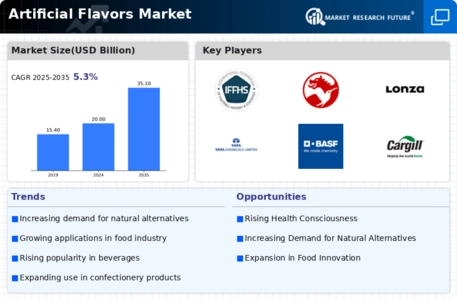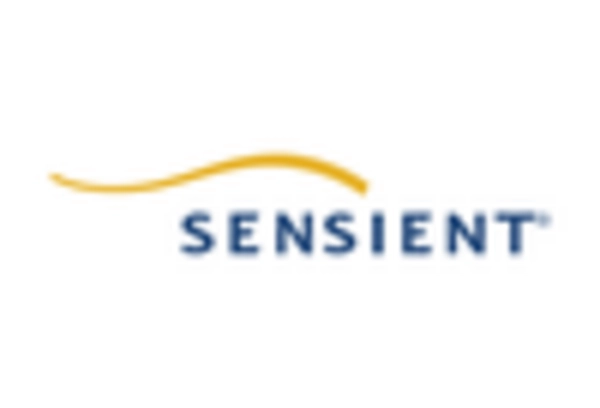Expansion of Beverage Sector
The beverage sector's expansion is a crucial driver for the Artificial Flavors Market. With the rising popularity of flavored drinks, including soft drinks, energy drinks, and alcoholic beverages, manufacturers are increasingly relying on artificial flavors to enhance taste and appeal. Recent statistics indicate that the beverage market is expected to grow by approximately 6% annually, driven by consumer preferences for unique and diverse flavor experiences. This growth presents a significant opportunity for the Artificial Flavors Market, as beverage producers seek to differentiate their products in a crowded marketplace. The ability to create distinctive flavors that resonate with consumers is essential for brand loyalty and market share, thereby propelling the demand for artificial flavoring solutions.
Innovation in Flavor Technology
Technological advancements in flavor development are significantly influencing the Artificial Flavors Market. Innovations such as encapsulation techniques and flavor modulation are enabling manufacturers to create more complex and appealing flavor profiles. These advancements not only enhance the sensory experience of food products but also improve the stability and shelf life of flavors. The market for flavor technology is expected to witness substantial growth, with estimates suggesting a rise of around 5% annually. As companies invest in research and development to create novel flavor solutions, the Artificial Flavors Market stands to benefit from an influx of innovative products that meet evolving consumer preferences. This trend indicates a shift towards more sophisticated flavor offerings, which could redefine the competitive landscape of the industry.
Rising Demand for Processed Foods
The increasing demand for processed foods is a primary driver of the Artificial Flavors Market. As consumers seek convenience and ready-to-eat options, manufacturers are compelled to enhance the taste of these products. According to industry reports, the processed food sector is projected to grow at a compound annual growth rate of approximately 4.5% over the next few years. This growth necessitates the incorporation of artificial flavors to meet consumer expectations for taste and quality. Consequently, the Artificial Flavors Market is likely to experience a surge in demand as food producers strive to create appealing flavors that cater to diverse palates. The ability to replicate natural flavors through artificial means allows manufacturers to maintain consistency and reduce costs, further driving the market's expansion.
Consumer Preference for Unique Flavors
The growing consumer preference for unique and exotic flavors is reshaping the Artificial Flavors Market. As consumers become more adventurous in their culinary choices, there is an increasing demand for flavors that offer novel experiences. This trend is particularly evident in the snack and dessert segments, where manufacturers are experimenting with unconventional flavor combinations. Market analysis suggests that the demand for unique flavors could lead to a growth rate of around 4% in the artificial flavors segment. This shift towards personalization and flavor exploration encourages companies to innovate and diversify their flavor offerings, thereby driving the Artificial Flavors Market forward. The ability to cater to these evolving tastes is crucial for companies aiming to capture the attention of discerning consumers.
Regulatory Support for Flavor Innovation
Regulatory support for flavor innovation plays a pivotal role in the growth of the Artificial Flavors Market. Governments are increasingly recognizing the importance of flavoring agents in food production and are establishing guidelines that facilitate the safe use of artificial flavors. This regulatory framework not only ensures consumer safety but also encourages manufacturers to explore new flavoring options. As regulations evolve, the market is likely to see an influx of innovative flavor solutions that comply with safety standards. The potential for new product development, supported by favorable regulations, could lead to a projected growth rate of 3% in the artificial flavors sector. This environment fosters creativity and experimentation, allowing the Artificial Flavors Market to thrive in a competitive landscape.


















Leave a Comment